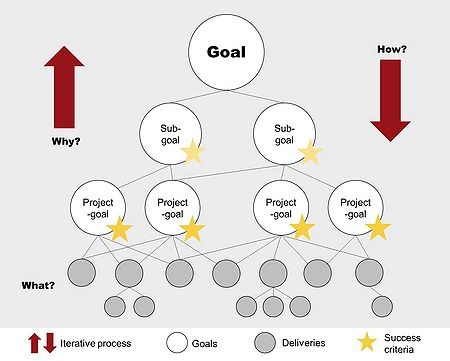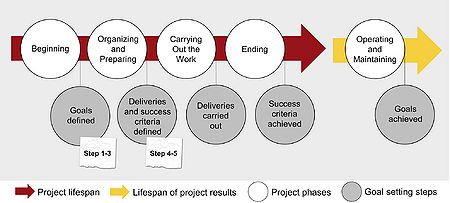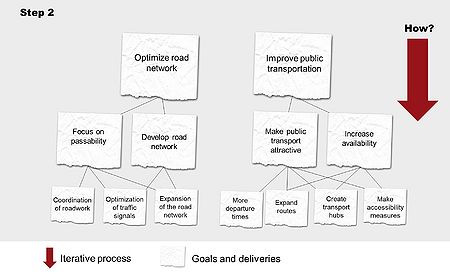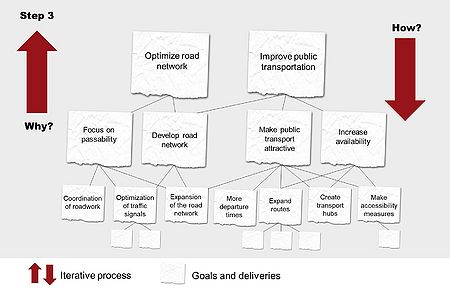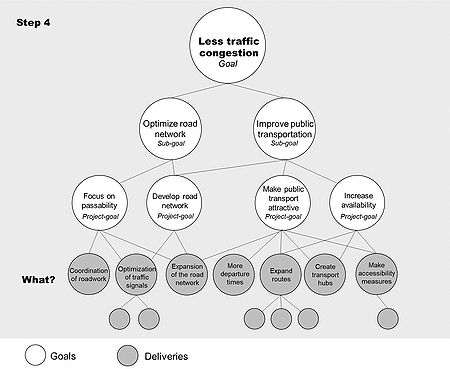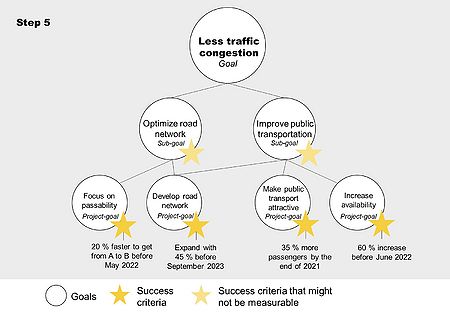Goal Hierarchy
When managing projects, it is important that they have a specific direction to be successful. The direction of the project can be found by defining the purpose. If there is no purpose, there is no reason to do the project. When breaking down the purpose in smaller parts the scope can be defined. The scope should only include the processes that will help you ensuring that the project will be a success. [1] One way to help you defining the scope of your project is to apply the Goal Hierarchy from the book ‘Power in projects, programs and portfolios’ [2] also known as Goal Breakdown Structure.
The Goal Hierarchy is a goal-oriented iterative method that can be used to define the scope of your project. This by setting goals that can be brought up to date as knowledge expands. [3] The method consists of a hierarchy with a main goal on top followed by sub-goals, project-goals, deliveries, and success criteria. The goals are broken down in different levels of details, by asking ‘why?’ and ‘how?’. You ask, ‘why are we doing this?’ to make sure the goals make sense and ‘how are we doing this?’ to make the goals specific. Since the method is an iterative process you ask the questions again and again to improve the goals. [4] It can be used for both project-, program- and portfolio management, however, the focus will be on using the method in a project management context.
This article will investigate the Goal Hierarchy and its purpose and how it can be applied to make your project more specific and goal oriented. The application of the method will be followed by its limitations with a critical reflection of the method and its application. Hence you will be aware of what the method can and cannot do and when it will be beneficial to use after reading this article.
Contents |
Context
The Goal Hierarchy is a method that is developed for project management within the purpose perspective to find out what the scope of the project is. This, as mentioned previously, does not mean that the method cannot be applied to other types of management such as program- and portfolio management. Program management involves several projects that cannot be solved individually to achieve an objective. [5] In those cases, the Goal Hierarchy could be extended to include more projects with the same main goal on the top of the hierarchy. This will make the process more complicated, but it is far from impossible. The same applies to portfolio management where one or more portfolios strive to achieve strategic objectives with selected programs or projects. [6] This type of management will also need an extended version of the method for it to be usable. This by customizing the method to the specific portfolio. Even though the method can be used for different management types, this article will focus on how to use the Goal Hierarchy as a project manager in order to simplify its use.
Description and Purpose
The Goal Hierarchy is a goal-oriented iterative method that can be used to help project managers define the scope of their project. This by figuring out what the project should lead to. When doing projects, you have to think about the end before the beginning, which is not an easy thing to do. Nevertheless, it is the place to start. If you do not have a goal from the beginning, it is impossible to known what you are searching for. However, it requires knowledge and an analysis to set goals, and with high uncertainties in the very beginning of the project this can be a challenge. The way to work around it is to define goals in different steps as knowledge of the project expands and the uncertainties decreases. [7] By using the Goal Hierarchy, you can get help with how to get started with your project goal setting as well as ensuring that you are on the right track throughout the project lifespan.
The method consists of three elements: goals, deliverables, and success criteria. Together they make a hierarchy of goals. To improve the understanding of the Goal Hierarchy, the figure 1 inspired by figure 3.8 (Attrup and Olsson) [10] and figure 17 (Geraldi, Thesen, Oehmen and Stringl) [11] has been developed while the use of it remains the same.
The goals are broken down in different levels of details: a main goal, sub-goals, and project-goals. They state where the project is heading and why the project is relevant. This by asking the questions ‘why?’ and ‘how?’ again and again to improve the goals doing the lifespan of the project. The question ‘why?’ is about making sure that the goals are relevant at all time. This forces the project manager to adjust the purpose as the project knowledge expands keeping the project up to date. The question ‘how?’ is about looking down in the hierarchy and reflect on whether what your doing is relevant. If not, the direction should be changed to achieve the goals. [12]
The deliverables can be found further down in the hierarchy. They describe what have to be delivered when the project is finished. You ask the question ‘what?’ to find out what to deliver to fulfil the purpose of the project. They can be described in further details with sub-deliverables as shown in Figure 1. [13]
The success criteria are added to be able to measure the goals to ensure that the impact you wish the project to fulfil becomes a reality. The success criteria should be measures as close as possible to the deliverables, since the project-goals are the goals that you have the most influence on. The higher you reach in the hierarchy the less you can make the criteria specific and useful. Furthermore, some success criteria might be more important that other. These can advantageously be added to the Goal Hierarchy to make a greater focus on meeting these specific criteria. [14]
In short, the connection between the three elements is that a project will carry out deliverables that creates an impact that can be measured with success criteria to find out if the goals are achieved. This will be elaborated in the next section.
Application
The Goal Hierarchy can be implemented in both project-, program- and portfolio management (as mentioned under the section ‘Context’). When working with a program- or portfolio management the method will naturally become more complex with an extended version of the hierarchy. Consequently, the focus of the following will be on projects to make the application as clear and usable as possible.
Project Lifespan
When talking about the application of the Goal Hierarchy in projects it is essential to be aware of the lifespan of projects. The project lifespan is a collection of different project phases from the beginning to the end of a project [17]. In figure 2 the application of the three elements: goals, deliverables, and success criteria from the Goal Hierarchy is shown in a project lifespan connection. The lifespan of projects consists of four phases. The first phase of the project is the beginning where the purpose and goals are defined. The goals can be developed and changed as knowledge expands in the project lifespan. The second phase is where the project is organized and prepared. In this phase the deliveries and success criteria are defined to make the project deliveries specific and the goals measurable. In the third phase the work and deliveries of the project is carried out. In the fourth and last phase of the project lifespan the success criteria should be achieved. Finally, after the project has ended the results of the project can be checked out by making sure the goals have been achieved.
Step by step
The purpose and main goal of a project are often formulated by a management, after which a project group aims to solve the task. To make the use of the Goal Hierarchy more understandable, five steps have been set out. Each step describes how parts of the method are used. [18] In figure 2 it is possible to see when in the project lifespan the different steps are to be performed.
Project case
Through all steps in the following, we will look at a fictive project case. The case is about a municipality that wishes to have ‘Less traffic congestion’ on their road network. The head of the road department finds out that the surrounding municipalities have the same challenges. Therefore, the municipality chooses to cooperate with them. Since the municipalities are not road owners of the largest traffic roads, people from the Danish Road Directorate gets associated with the project. The project group now consists of various professionals with one project manager. To reach the goal of having ‘Less traffic congestion’ they use the Goal Hierarchy.
1. Define the goals
The first step is about defining the goals. When using the Goal Hierarchy, you do not necessarily have to start by looking at the purpose of the project. Of course, the purpose is the reason why we are doing projects, however, by searching for goals the purpose might become clearer. This can be done by for example applying post-it notes on a board or wall by members from the project group. Doing so you can create a number of goals and then move the post-it notes up and down in the hierarchy by asking the questions why?' and ‘how? repeatedly.
With the case of the municipalities that wants to have less traffic congestion, the project manager can examine: ‘how can we achieve the purpose: Less traffic congestion?’. The answer to this may be by optimizing the road network and improving the public transportation (see figure 3). For each of the goals there is an outcome, which is to have a better road network and public transport. To get back into the hierarchy, the project manager can then ask the question: ‘why should we optimize the road network and improve public transport?’. The answer to this is to get less traffic congestion. This iterative process can be made as the knowledge expands in the first phase of the project improving the goals and thereby the purpose of the project.
Limitations
...
Annotated Bibliography
- Attrup, M. L. and Olsson, J.R. , Power i projekter og portefølje, DJØF Publishing (2008), ISBN: 978-87-574-1665-7
This book provides an insight into how to apply the Goal Hierarchy step by step. It is also possible to get concrete and easy to read examples of how the method is used, which makes the book very useful. In general, the book provides with lots of useful tools to manage projects in practice and it is therefore highly recommended.
- Project Management Institute, Inc.. (2017). Guide to the Project Management Body of Knowledge (PMBOK® Guide) (6th Edition). Project Management Institute, Inc. (PMI). Retrieved from https://app.knovel.com/hotlink/toc/id:kpGPMBKP02/guide-project-management/guide-project-management
This book is a standard that provides basic knowledge of project-, program-, and portfolio management, however, the focus is mainly on project management. To get an insight of how the Goal Hierarchy can be used in the differnet types of management, the standard is used to distinguish differences and understand what the objectives are within each form of management. The book is not the easiest to read, but if you are looking for answers to something specific, it is definitely useful.
- Geraldi, J., Thuesen, C., Oehmen, J., & Stingl, V. (2017). How to DO Projects? A Nordic Flavour to Managing Projects. Dansk Standard. DS Handbook Vol. 185
This book provides insight into the project management's four perspectives: purpose, people, complexity and uncertainty. The book shows an extended version of the Goal Hierarchy based on figure 38 from Olsson and Attrup, 2015, in chapter 6. The biggest difference is that the Goal Hierarchy is shown in one overall figure. The book can be recommended since it consists of useful theories and methods of project management.
References
- ↑ Project Management Institute, Inc.. (2017). Guide to the Project Management Body of Knowledge (PMBOK® Guide) (6th Edition) - 5. Project Scope Management, page 129. Project Management Institute, Inc. (PMI). Retrieved from https://app.knovel.com/hotlink/pdf/id:kt011DX4T1/guide-project-management/project-scope-management
- ↑ Attrup, M. L. and Olsson, J.R., Power i projekter og portefølje, DJØF Publishing (2008), ISBN: 978-87-574-1665-7
- ↑ Attrup, M. L. and Olsson, J.R. , Power i projekter og portefølje, page 100, DJØF Publishing (2008), ISBN: 978-87-574-1665-7
- ↑ Geraldi, J., Thuesen, C., Oehmen, J., & Stingl, V. (2017). How to DO Projects? A Nordic Flavour to Managing Projects, page 113. Dansk Standard. DS Handbook Vol. 185
- ↑ The Standard for Program Management — fourth edition, page 10. (2017). ProQuest Ebook Central https://ebookcentral-proquest-com.proxy.findit.dtu.dk
- ↑ Project Management Institute, Inc.. (2017). Guide to the Project Management Body of Knowledge (PMBOK® Guide) (6th Edition) - 5. Project Scope Management, page 13. Project Management Institute, Inc. (PMI). Retrieved from https://app.knovel.com/hotlink/pdf/id:kt011DX4T1/guide-project-management/project-scope-management
- ↑ Attrup, M. L. and Olsson, J.R., Power i projekter og portefølje, page 96, DJØF Publishing (2008), ISBN: 978-87-574-1665-7
- ↑ Attrup, M. L. and Olsson, J.R. , Power i projekter og portefølje, figure 3.8, DJØF Publishing (2008), ISBN: 978-87-574-1665-7
- ↑ Geraldi, J., Thuesen, C., Oehmen, J., & Stingl, V. (2017). How to DO Projects? A Nordic Flavour to Managing Projects, figure 17. Dansk Standard. DS Handbook Vol. 185
- ↑ Attrup, M. L. and Olsson, J.R. , Power i projekter og portefølje, figure 3.8, DJØF Publishing (2008), ISBN: 978-87-574-1665-7
- ↑ Geraldi, J., Thuesen, C., Oehmen, J., & Stingl, V. (2017). How to DO Projects? A Nordic Flavour to Managing Projects, figure 17. Dansk Standard. DS Handbook Vol. 185
- ↑ Attrup, M. L. and Olsson, J.R., Power i projekter og portefølje, page 99, DJØF Publishing (2008), ISBN: 978-87-574-1665-7
- ↑ Attrup, M. L. and Olsson, J.R., Power i projekter og portefølje, page 99-100, DJØF Publishing (2008), ISBN: 978-87-574-1665-7
- ↑ Attrup, M. L. and Olsson, J.R., Power i projekter og portefølje, page 100, DJØF Publishing (2008), ISBN: 978-87-574-1665-7
- ↑ Attrup, M. L. and Olsson, J.R. , Power i projekter og portefølje, figure 3.4 page 96, DJØF Publishing (2008), ISBN: 978-87-574-1665-7
- ↑ Project Management Institute, Inc.. (2017). Guide to the Project Management Body of Knowledge (PMBOK® Guide) (6th Edition), figure 1-5 page 18. Project Management Institute, Inc. (PMI). Retrieved from https://app.knovel.com/hotlink/toc/id:kpGPMBKP02/guide-project-management/guide-project-management
- ↑ Project Management Institute, Inc.. (2017). Guide to the Project Management Body of Knowledge (PMBOK® Guide) (6th Edition) - 5. Project Scope Management, page 19. Project Management Institute, Inc. (PMI). Retrieved from https://app.knovel.com/hotlink/pdf/id:kt011DX4T1/guide-project-management/project-scope-management
- ↑ Attrup, M. L. and Olsson, J.R., Power i projekter og portefølje, page 101-108, DJØF Publishing (2008), ISBN: 978-87-574-1665-7
- ↑ Attrup, M. L. and Olsson, J.R. , Power i projekter og portefølje, figure 3.6 page 102, DJØF Publishing (2008), ISBN: 978-87-574-1665-7
- ↑ Geraldi, J., Thuesen, C., Oehmen, J., & Stingl, V. (2017). How to DO Projects? A Nordic Flavour to Managing Projects, figure 17. Dansk Standard. DS Handbook Vol. 185
- ↑ Attrup, M. L. and Olsson, J.R. , Power i projekter og portefølje, figure 3.7 page 103, DJØF Publishing (2008), ISBN: 978-87-574-1665-7
- ↑ Geraldi, J., Thuesen, C., Oehmen, J., & Stingl, V. (2017). How to DO Projects? A Nordic Flavour to Managing Projects, figure 17. Dansk Standard. DS Handbook Vol. 185
- ↑ Attrup, M. L. and Olsson, J.R. , Power i projekter og portefølje, figure 3.8, DJØF Publishing (2008), ISBN: 978-87-574-1665-7
- ↑ Geraldi, J., Thuesen, C., Oehmen, J., & Stingl, V. (2017). How to DO Projects? A Nordic Flavour to Managing Projects, figure 17. Dansk Standard. DS Handbook Vol. 185
- ↑ Attrup, M. L. and Olsson, J.R. , Power i projekter og portefølje, figure 3.8, DJØF Publishing (2008), ISBN: 978-87-574-1665-7
- ↑ Geraldi, J., Thuesen, C., Oehmen, J., & Stingl, V. (2017). How to DO Projects? A Nordic Flavour to Managing Projects, figure 17. Dansk Standard. DS Handbook Vol. 185
- ↑ Attrup, M. L. and Olsson, J.R. , Power i projekter og portefølje, figure 3.10 page 108, DJØF Publishing (2008), ISBN: 978-87-574-1665-7
- ↑ Geraldi, J., Thuesen, C., Oehmen, J., & Stingl, V. (2017). How to DO Projects? A Nordic Flavour to Managing Projects, figure 17. Dansk Standard. DS Handbook Vol. 185
